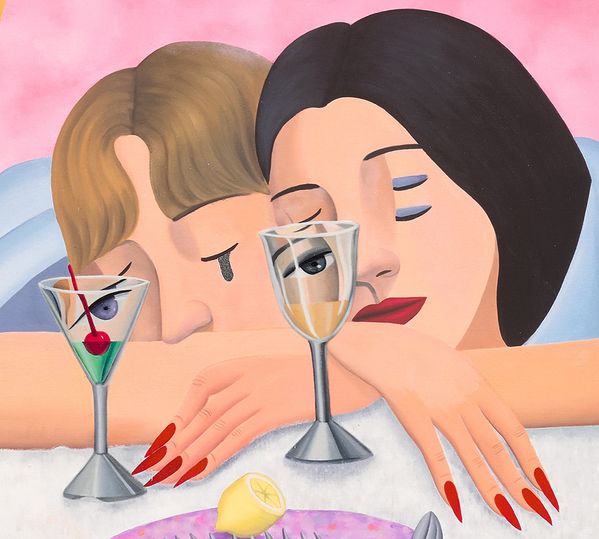GaHee Park, Tipsy Lovers (detail), 2021. Evening & Day Editions, London.
The journey of an image begins with the sight of its maker. There is an inherent power imbalance in this premise. The subject of an image is visually consumed twofold, by both the creator and the viewer of the image. When that subject is the female nude — perhaps the most prolific motif in art history — critical questions around agency and objectification come to light.
We’re talking, of course, of the “male gaze” — the now pervasive term popularized by Laura Mulvey’s groundbreaking 1973 essay “Visual Pleasure and Narrative Cinema.” In the years since the essay’s publication, artists have reconsidered their approach to image making — particularly when their subjects are women — and women artists have upended this notion by creating work from the perspective of the female gaze.
In this premise, the visual perspective of men has been prioritized throughout most of history. This is clearly seen through the depiction of hyper-sexualized images that present female bodies and personalities as objects intended for the visual consumption of men, both through the eyes of the artist and the viewer.
However, too often we look only to the work of women artists to dismantle these ideas. But the obligation is also on us as viewers to call into question our own gaze, whose gaze we’re observing, and in what context. Several works in our upcoming Evening & Day Editions auctions in London offer the opportunity to consider the gaze (both of the artists and of ourselves) across different eras and approaches to image making.
“I find it interesting that there might be this assumption that, as a woman, it is somehow my role to represent women in a way that should be empowering.”
—Caroline Walker
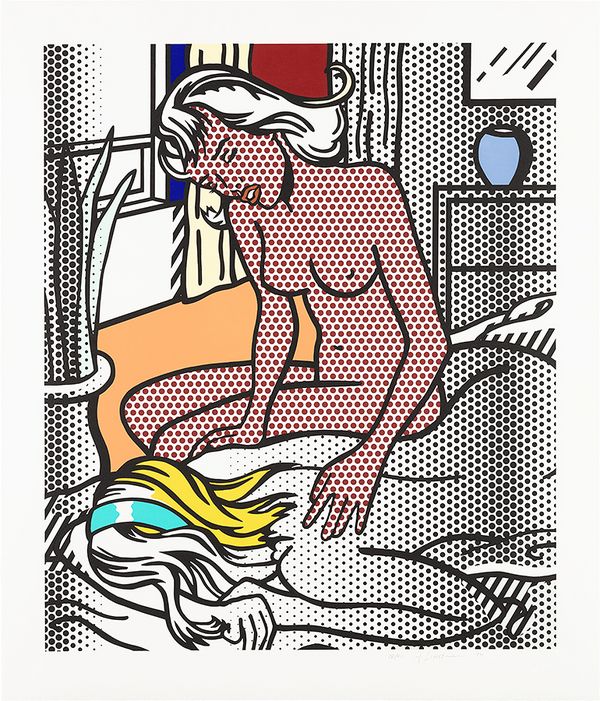
Roy Lichtenstein, Two Nudes, from Nudes Series. Evening & Day Editions, London.
In his 1994 work Two Nudes, Roy Lichtenstein directly confronts the male gaze as an idea unto itself by attempting to delete it. The source for this image — the August 1963 #94 issue of Girls’ Romances, a romance comic anthology published by DC Comics — contained a text bubble which made it clear that the standing figure was comforting her friend in the wake of a rift with a presumed boyfriend (who was not-so-subtly named “Dick”). On the dresser in the room were make-up and hair products as well as a photograph of a man (who we presume to be said “Dick”).
It's through the deletion of these visual elements that Lichtenstein so astutely removes connotations of the male gaze. In turn, the subjects of the image appear independent and free of longing for a male presence. This stands in stark contrast to earlier works of Lichtenstein which depict crying and distraught women, perhaps reflecting another trope of the male gaze — the depiction of women as emotional objects in need of a man’s comfort.

Henri Matisse, Nu couché. Intérieur à la lampe Vénitienne (Reclining Nude. Interior with Venetian Lamp), 1929. Evening & Day Editions, London.
Yet, even in the deletion of the male presence, the undertones of the male gaze are still present in Two Nudes, leading to a heightened ambiguity which complicates our contemporary viewing of the work. The notion of the male gaze, even if not the vision of it, is perhaps just as forefront on our minds when viewing Two Nudes as it is when viewing Lichtenstein’s forebears, such as Matisse or Picasso. In depicting the motif of the female nude in his own iconic visual language, Lichtenstein acts just as Matisse or Picasso had, but a feminist critique of his own sight is now part of his image. Though this consideration may not have been present in the gaze of Matisse or Picasso when they made these works, it can be in ours.
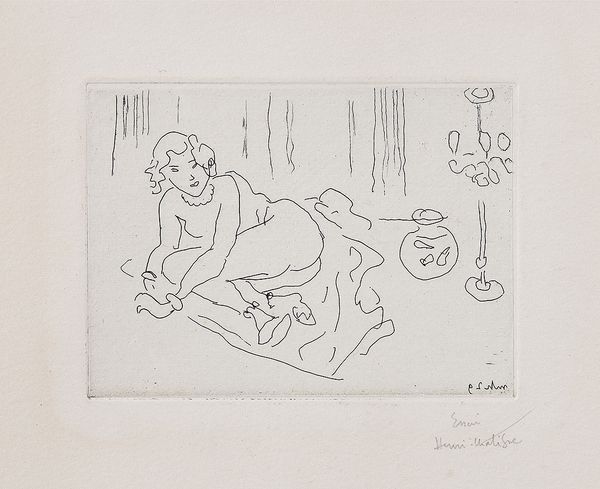
Henri Matisse, Le repos du modèle (Model in Repose), 1922. Evening & Day Editions, London.

Tracey Emin, Kate Moss 2000, 2006. Evening & Day Editions, London.
To British artist Tracey Emin, the upending of the male gaze has been a prevailing theme across her decades-long practice of depicting female nude subjects, including herself. Yet the opposing vision of that other protagonist — the viewer — can sometimes be a challenge. She’s confronted this issue, once recalling, “Some critic said I was influenced by Matisse … And I asked, ‘Are you saying that Matisse owns the way that women sit?’”

Tracey Emin, Curled Up, 2022. Evening & Day Editions, London.
In a contemporary consideration of any male artist’s depiction of female nudes, even when the notion of objectification in the male gaze is subverted by the artist, they cannot escape its pervasive existence. In her recent essay “The Invention of the ‘Male Gaze’” published in The New Yorker, cultural critic Lauren Michele Jackson points out that “contrary to Mulvey’s approach, uses of the ‘gaze’ today — be it the male gaze, the white gaze, and so forth — seem to be more invested in matters of identity than in the project of aesthetic analysis. They want to name who is doing the looking rather than how.” This idea leads to further nuance we must consider as viewers: How does the artist’s gaze change depending on their identity or cultural background, beyond only gender? How does our own vision and understanding of an artist change based on our experience?
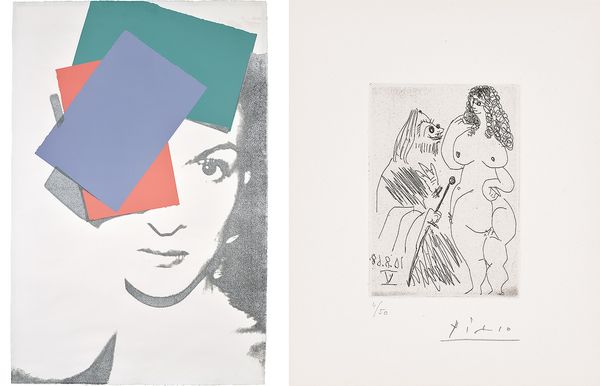
Left: Andy Warhol, Paloma Picasso, from Hommage à Picasso, 1975. Right: Pablo Picasso, Jeune prostituée et vieillard aux yeux exorbités (Young Prostitute and Old Man with Bulging Eyes), 1968.
“Art history taught me that, historically, women didn’t have time to think thoughts — they were too busy napping naked alone in a forest.”
—Hannah Gadsby, ‘Nanette’
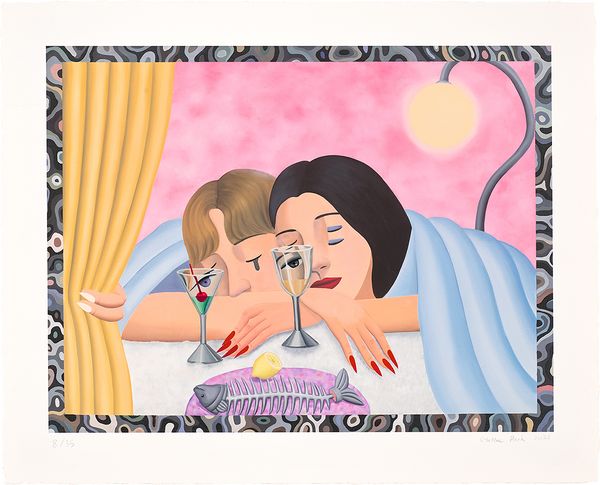
GaHee Park, Tipsy Lovers, 2021. Evening & Day Editions, London.
With this in mind, we turn to contemporary interpretations of the concept in the work of Korean-born artist GaHee Park. Her work Tipsy Lovers challenges us with the implication of nudity concealed underneath the blanket seen covering the figures. Heightening the visual idea of fabric as a covering are the fingers of an unseen third figure, which are either pulling back the curtain to invite us to view or shutting us out of sight. As viewers, we find ourselves in a voyeuristic position that is heightened by the direct gaze of the surreal open eyes that confront us through the wine glasses, questioning both the right and the credibility of our own fixation.
A reclamation of the female figure is important to Park, who was raised in a traditionally patriarchal Catholic household in Korea. Her childhood notebooks of drawings functioned as means to assert her feminine agency. She kept these notebooks private, often gluing the pages together to hide certain images. As she recalls, “I was drawing some sexual images, what one would deem as forbidden stuff. It was a way of rebelling and asserting myself, I guess.” On her observation of the male gaze in Korean society, she fondly remembers time spent with her mother in traditional Korean baths, remarking that they are “this liberating zone where, unlike in everyday life in Korea, women can be nude without being sexualized by the presence and gaze of men.”

Caroline Walker, Island Resort, 2014. Evening & Day Editions, London.
The notion of the gaze is crucial to Caroline Walker’s work, whose self-possessed female subjects often appear oblivious to or unfazed by the viewer’s presence. Our presence in her scenes is intentionally amplified by the scale of her surfaces. Like many artists, Walker has also pointed out differences in the understanding of her work from male and female viewers, noting that women “see themselves in those positions, whereas, I suppose, men are approaching it more objectively, as an onlooker.” She further notes that she is interested in “the relationship between women, or how women perpetuate their own position in a patriarchal society.”
The result are images that seem to specifically place us as voyeuristic protagonists in the scenes. The unnerving position we find ourselves in as viewers serves as a direct reminder to confront the perspective of our own gaze. As Lucy Lippard so succinctly points out, “It’s a subtle abyss that separates men’s use of women for sexual titillation from women’s use of women to expose that insult.”
Discover More from Evening & Day Editions, London >
Recommended Reading
